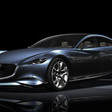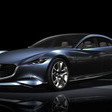You can login to your account or create a new account.
You can login to your account or create a new account.
You can login to your account or create a new account.
At the 2010 Los Angeles Auto Show, Mazda North American Operations debuted the Shinari concept car.
The Shinari design concept was the first vehicle to feature Mazda’s new global design language, Kodo, or the “Soul of Motion.” The design had been conceived under the direction of Ikuo Maeda, the company’s Global Design Director and evoked lessons learned from the successful Nagare series of concepts, taking them to another level. Although people will never see a vehicle like this on the road, the designs works as a learning tool, offering new ways to explore form and surface language.
The Shinari is a pure design concept model of a four-door, four-seater sports coupe which expresses the Kodo design theme. In Japanese, the word shinari is used to describe the powerful yet supple appearance of great resilient force when objects of high tensile strength, such as steel or bamboo, are twisted or bent. It also refers to the appearance of a person or animal as it flexibly transforms its body to generate a fast movement.
Mazda
In 1927, the company’s name was shortened to ‘Toyo Kogyo Co.’ and it remained like so until 1984, although all the vehicles produced carried the Mazda nameplate ever since the company’s inception. In Japanese, the company’s current name and all its vehicles are spelled and pronounced ‘Matsuda’, just like its founder’s last name. It has been translated into ‘Mazda’ on our alphabet for two reasons... more





